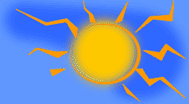 |
|
Air Pollution
|
 |
|
How Air is Polluted
Air is polluted by the introduction od dust and smoke particles, as well as the release of harmful gases into the air. The harmful gases inculde sulphur dioxide, chlorofluorocarbons (CFCs) and nitrogen oxides. These pollutants cause servere problems such as haze, smog, acid rain, depletion of the ozone layer and global warming. Air pollution can be due to natural or human causes. Erupting volcanoes as well as forest fires caused by hot and dry weather send large amounts of dust and smoke into the air. Increasingly, however, human activities have also contributed to air pollution. Yearly, industries emit large amounts of toxic gases into the air. The vehicles we drive release harmful gases such as nitrogen oxides and carbon monoxide. The aerosal cans of insecticide and hair spray that we use sometimes contain CFCs that destroy the ozone layer.
What are Haze and Smog
Haze is a suspension of dust and smoke particles in the atmosphere which affects how far or how clearly we see. Compared to haze, smog is a more servere form of air pollution. In addition to dust and smoke particles, it also consists of a dangerous mixture of toxic gases. These gases include carbon monoxide, nitrogen oxides and sulphur dioxide.
Cause of Haze and Smog
The dust and smoke particles produced by natural causes such as forest fires and volcanic eruptions contribute to the probles of haze and smog. Human activities such as construction work and the use of diesel fuel in vehicles are other causes of haze and smog. In many cities, 90 percent of dust and smoke particles is believed to come from the emissions of vehicles. Vehicles also release carbon monoxide and nitrogen oxides into the air. In addition, industries and power stations which burn fossil fuels emit a lot of sulphur dioxide. Thus,haze and smog are more common in developed countries and industrial areas, where there are likely to be more vehicles and factories.
|
|  |
|

